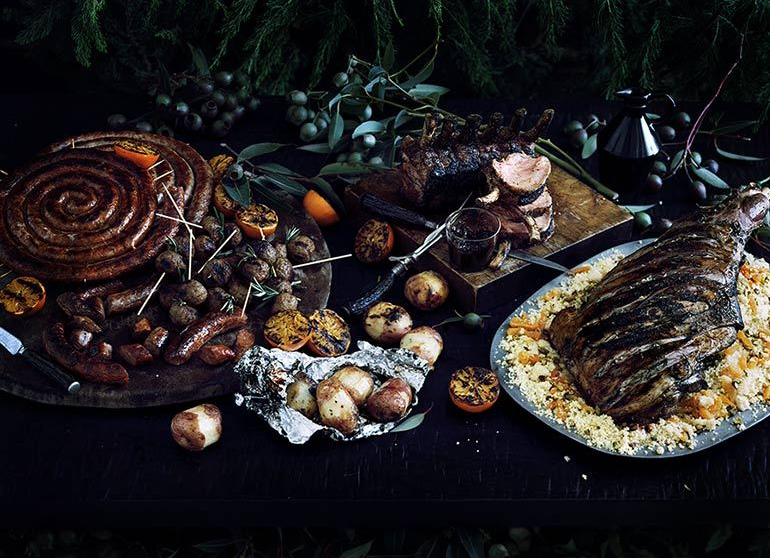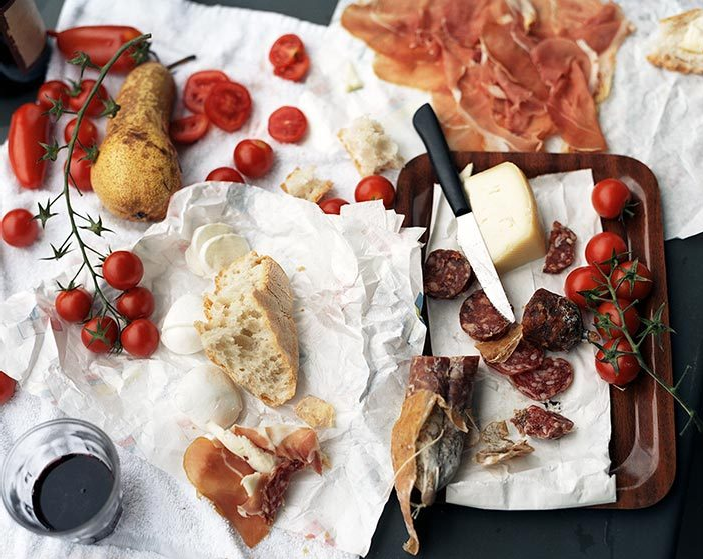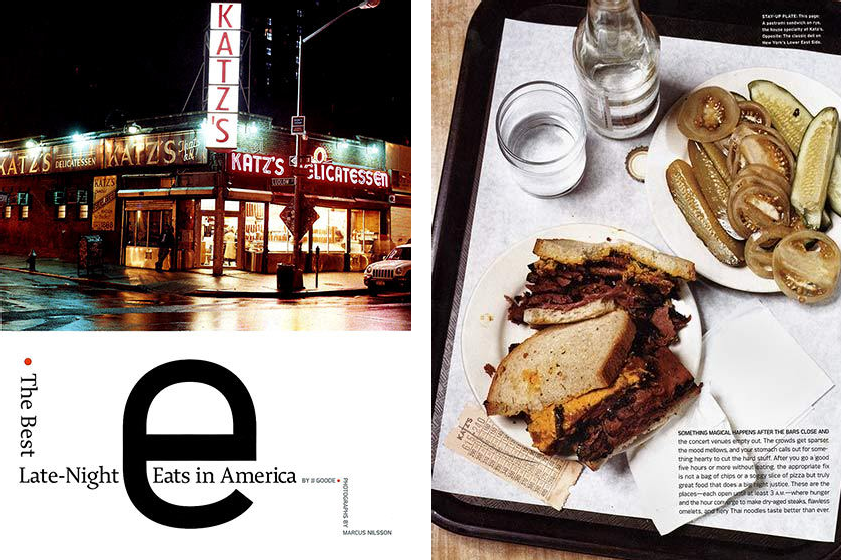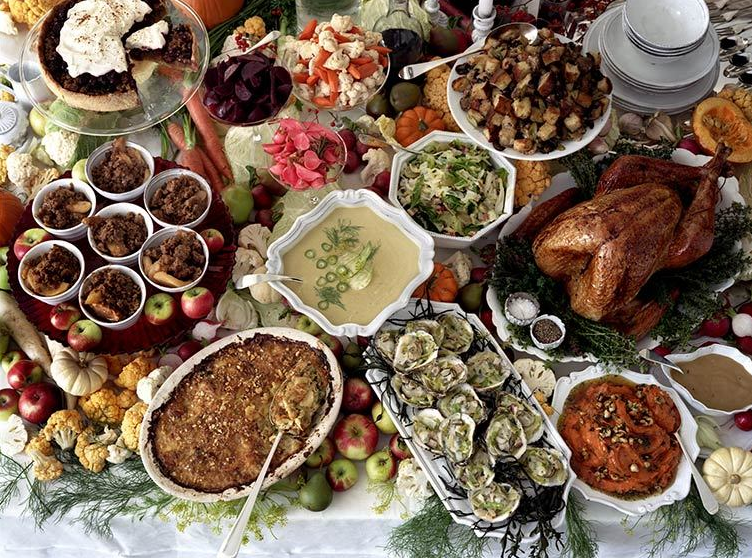Marcus Nilsson thinks outside the box. A former chef, Nilsson stumbled into food photography and ended up being one of the photographers who shaped our contemporary approach to cuisine. Today, Nilsson is still pushing that envelope (with on-camera flash, what?!), and regularly works for some of the world’s top foodie magazines, including Bon Appetit, Food & Wine, Martha Stewart Living, Details, Esquire, Everyday with Rachael Ray, the Food Network, GQ, and Travel+Leisure. Check out the full FS Spotlight interview below, where Nilsson dishes on shooting on-camera flash, tilt-shift lenses, crazy Mexican market foods, and why he hates sandwiches.
Fstoppers: How did you get into photography?
Marcus Nilsson: I was always painting and drawing when I was younger, I was very much into fine art, but I worked as a chef full time for many years. After 10 years or so working in the restaurant business, I decided to go to school for art here in New York. I quit cooking at 28, and I went to school for fine art. I meant to do painting and drawing, but I took a black and white photography class, a 101 darkroom class, and I kind of fell in love with photography. Before that I didn’t really do any photography, just snapshots like everybody else. I fell in love with it there in the darkroom, the black and white and the film.
 Fstoppers: Was it a natural progression to shooting cuisine?
Fstoppers: Was it a natural progression to shooting cuisine?
Marcus Nilsson: That’s also something that I didn’t plan, even though I’d gone to culinary school and I’ve cooked. I know a lot about food and I loved food, but I didn’t like food photography at all. I read cook books and magazines, but I never really liked the way it was photographed and presented. I was photographing more fine art still lifes and there would be body parts in there, an arm or a leg or something, but there would also be food in the picture. Most often it wasn’t about the food, and there would be a piece of chocolate cake in the corner. It was more about the other things that were going on.

I ended up shooting food commercially because of Richard Ferretti, who was the creative director at Gourmet magazine in 2005, he contacted me. I had a super ugly, homemade website that I’d made in Word - it was terrible! - but I had a few of my still lifes and some really gritty black and white photographs of chicken feet and pigs’ feet, and he saw those pictures and called me and asked me if I’d like to shoot a feature for Gourmet magazine. I’d never done a job in my whole life! He was looking for a new way of looking at food, and I think he changed the way people look at food in general today. He was the one who got me shooting food! He saw something in my photography, because I wasn’t brainwashed, you know? I wasn’t a food shooter. I realized after shooting that story that I didn’t have to shoot food in a specific way. It doesn’t have to look like Martha Stewart did back in the day, where everything was neat, backlit, with a soft focus. I shot sharp pictures, and I wanted my food to look touched, like a sophisticated snap shot... though it is very planned out. I’m a perfectionist, but it doesn’t look fake. So after that I had more jobs than I could take. And now everybody shoots like that!
Fstoppers: It seems like there are definite trends in food photography. What was it like when you started, and where do you think it is now?
 Marcus Nilsson: When I started they would put the plate on the pretty napkin that was ironed and folded, and they would have the utensils sitting perfectly: knife to the right with the fork to the left. Things would often be backlit with very soft focus, and there would be “lifestyle” people with very white teeth and shit like that. And that’s how it used to looked, and then it wasn’t just me, it was a group of people that started doing things differently but it started a whole new trend. Now it’s more relaxed, and they want it to be a bit darker and not so precious.
Marcus Nilsson: When I started they would put the plate on the pretty napkin that was ironed and folded, and they would have the utensils sitting perfectly: knife to the right with the fork to the left. Things would often be backlit with very soft focus, and there would be “lifestyle” people with very white teeth and shit like that. And that’s how it used to looked, and then it wasn’t just me, it was a group of people that started doing things differently but it started a whole new trend. Now it’s more relaxed, and they want it to be a bit darker and not so precious.
Fstoppers: Do you always work with a food stylist?
Marcus Nilsson: No, not always.
 Fstoppers: What sort of role do they play in the process when they work with you?
Fstoppers: What sort of role do they play in the process when they work with you?
Marcus Nilsson: Well, I do a lot of personal assignments when I do the food, and I do a lot of travel assignments and travel all over the world for Bon Appetite, Departures, Martha Stewart, Travel & Leisure... GQ sends me places as well, and Details magazine. When I go on those jobs, it’s just me and my assistants, and I do all the food. When I go someplace and a photograph a sandwich or a plate of food in someone’s home, of course whoever cooks the food does the main thing, but we always discuss how to plate it and what to plate it on. And I always put my fingers in it. I always shoot the food untouched, and then I move things around, and take a picture. And then I start eating. I’ll take a bite, and take a picture. And then I’ll take another bite, and another picture. I eat through the plate until I think it’s not worth shooting anymore, usually that’s how it works.
Fstoppers: What is it that you look for in a good photograph?
Marcus Nilsson: The difference between a good photographer and a bad photographer is that the good photographer sees what the other photographer doesn’t see. It’s all about seeing things. If we do a still life with plates, it just have to feel right throughout the image. It has to feel natural, it’s hard to explain.
Fstoppers: How do you describe the look of your photos? Give me three words.
Marcus Nilsson: That’s where I was lacking in art school, I’m not good at talking about my work. (laughs) When you see something, your eye responds and you take a picture and that’s what it is to me. There’s no philosophy, there’s no deeper meaning. My pictures don’t look too staged. I’m looking at a still life of fruit right now... it’s sexy? Maybe there’s a certain mood in them.
Fstoppers: How do you approach lighting?
Marcus Nilsson: I shoot most of my stuff in daylight, and it depends on what I’m looking for in the picture, but usually I prefer northern light. It’s a colder light, a softer light. I think it works great for food. I’m very picky with the light. If I’m shooting daylight and the light’s not right? I won’t shoot. If we’re working on a set up and the light changes, we either have to wait for the light to get good again or move it somewhere else.
Fstoppers: So most of it is natural light?
Marcus Nilsson: It is. I do light stuff as well, sometimes I even use on-camera flash. I had a big project I was working on in Mexico City last year, where I shot everything on-camera flash...
Fstoppers: Really?!
Marcus Nilsson: Yeah, it’s a new style for me. Like I said before, what I did and what I’ve done before... it’s everywhere now. Everyone shoots like this. Everybody’s talking about this, especially art directors when they’re talking about how something should be shot. It took years for my style to get on the page of a magazine and now everybody wants to shoot like that, and I’m bored, kind of. I’m looking for new ways to do it! I’m looking at these pictures - I have a whole series here on my wall - and I would say the composition is exactly my style. I shoot most of my stuff overhead, but instead of having that daylight that I usually shoot, I have on-camera flash and it looks great. So yes, I do other stuff, but most of it is daylight. Daylight is rich and soft, and while it could be very harsh, it’s a whole different animal than lighting with strobes. Sometimes when I shoot advertising, I mimic daylight with strobes, and I can hardly tell the difference myself in the end.
Fstoppers: What do you shoot with?
 Marcus Nilsson: When it comes to lenses, I don’t like too many options. When I first started shooting, I think I only had one lens, maybe two. When I first started shooting, I was shooting on a Pentax 67 and a Mamiya RZ67. So I had a normal lens and a slightly wider lens, so like a 105mm and a 90mm or a 75mm or something like that. No long lenses, I never used long lenses. Now I’ve moved on to 4x5. Most of my stuff I shot my first three years as a photographer, I shot on large format film and I only used one lens.
Marcus Nilsson: When it comes to lenses, I don’t like too many options. When I first started shooting, I think I only had one lens, maybe two. When I first started shooting, I was shooting on a Pentax 67 and a Mamiya RZ67. So I had a normal lens and a slightly wider lens, so like a 105mm and a 90mm or a 75mm or something like that. No long lenses, I never used long lenses. Now I’ve moved on to 4x5. Most of my stuff I shot my first three years as a photographer, I shot on large format film and I only used one lens.
Fstoppers: Do you still shoot film?
Marcus Nilsson: No, not very much. I still have the cameras and I take them out every once in a while. I have two cameras that I shoot with digitally, I have a Phase One camera with a Phase One digital back. It’s called P45 +. With that, I use the 80 lens, which is the normal lens. I shoot basically everything with an 80mm lens on that camera. I have a 5D Mark II as well, and the same thing there. I have a 90mm shift lens, and I have a 50mm. The shift lens I use to pull everything in focus, but I don’t like shooting at deep f-stops. I don’t like going too far down on the lens. I love shooting with the tilt lens, because I can put everything in focus that’s important, which since I shoot overhead is about 80% of the picture. But still it’s a huge difference. The 90mm tilt-shift on the 5D is amazing, but the P45 + is my favorite.
 Fstoppers: How much time do you spend editing, and how much post-production work do you do?
Fstoppers: How much time do you spend editing, and how much post-production work do you do?
Marcus Nilsson: When I first started, I was terrible at editing. It took me forever, I could never decide on pictures. Now I shoot so much, I have more work than I can take and on top of that I also do personal stuff. I’ve gotten really good at editing, it’s something you pick up and get better at as you go. I can edit pretty quick these days! Some projects I take longer than others, like personal projects can take longer than jobs for some reason. Post-production what I do is I shoot tethered or on cards depending on the situation, and most of the time I shoot tethered on Capture 1 6 and we make the files look nice there and then we process them to TIFs and then I work on them in Photoshop. And there’s hardly ever any retouching. If there’s a celebrity, I might make them look younger, take out some wrinkles here and there, but that’s usually on the client’s request. If people have black bags under their eyes, I like that. If they’re wrinkly, I like that. I try to get that rich film look, I have a few tricks in Photoshop but nothing groundbreaking I guess.
Fstoppers: What is your favorite food to eat?
Marcus Nilsson: I get that question a lot. I have different favorites throughout the year. I drink a lot of wine and collect wine, and I drink different wines in different seasons. Right now it’s cold, so I eat more meats, stews, whole birds, and I drink darker, heavier wines. In the summer, I love salads and vegetables. I eat anything and everything, I have a few favorite dishes but there’s nothing I’d want to eat forever. I get bored quickly.
 Fstoppers: What is your least favorite food to photograph?
Fstoppers: What is your least favorite food to photograph?
Marcus Nilsson: Hamburgers and sandwiches! I hate sandwiches. (laughs) I just got asked to do a big cookbook on hamburgers and sandwiches, and I turned it down because I was going to have to shoot 40 or 50 recipes, and I have a hard time taking one good photograph of a sandwich. I mean, I’ve done it and I do good hamburgers, but it’s very limiting. If you do a book or project when you have lots of them, it’s hard to get a variation on them. There’s no so many options. People normally like to shoot them at a low angle, and I don’t like to shoot at a low angle. I like to shoot overhead.
Fstoppers: What is the most exotic dish that you’ve ever shot?
Marcus Nilsson: Maybe something in Mexico City. There are markets down there where they sell all kinds of stuff that I really wouldn’t like to eat. They sell these worms that are alive and ants and ant eggs. I’m not grossed out by that, I appreciate it, but you’re also in an environment where the smells overwhelm you every step you take. There are little bunny rabbits with the fur on their head and feet only, and then you take another step and there’s worms crawling around in a bucket. And then there’s a bicycle with some goats’ heads in the basket, and it’s craziness. I find it fascinating and I love it, but it’s an experience.
Fstoppers: What’s the biggest mistake that young photographers make when they first start out shooting cuisine?
Marcus Nilsson: They don’t have their own style. They need to find their own voice. No matter what you shoot, if you copy what’s in the magazines or another photographer, you have to find something unique and special. There are so many photographers out there, why would they need another one that shoots like everyone else?
Fstoppers: What would you say is the secret of your success?
Marcus Nilsson: I know what I like, and I have a personal style in the way I photograph. That’s why Richard Ferretti picked me up, I guess. He saw something in me, he believed in me.
Fstoppers: What’s next for you?
Marcus Nilsson: I’m doing a big advertising campaign for a big American food company and then after that I’m working on a cookbook with Danny Meyer and Michael Romano, you know, the Union Square Hospitality Group. They own Maialino, Gramercy Tavern, a lot of restaurants, and they’re doing a cookbook on the family meal. It will be part portraits, part food. I’ve also been working on a project in Mexico City, as I mentioned earlier, for Swallow magazine, which is a really interesting magazine that’s worth mentioning. We’re having a launch party in New York City and one in Mexico City. There are also plenty of personal projects that I’m working on, and Swallow offers a really fresh perspective on cuisine, which we need.












![[FS Spotlight] Photographer Antoine Verglas on Lingerie, Swimsuit, and Fashion Photography](https://cdn.fstoppers.com/styles/small-16-9/s3/wp-content/uploads/2012/01/Leigh_SaintTropez-fashion-photography.jpg)



He could certainly use some different shooting angles. Most if not all of his pictures are plain, boring top views of the dishes.
That's his style I guess.
That's right. What I like about his pictures is, that he is not overdoing his editing making the food looking "yummi" but artificial.
I love that it all looks kind of messy and touched. I remember when I first started shooting food, everyone would freak out if there was a drip or a flake of parsley in the wrong place. Does anyone else remember those days?
There is something so overly decadent and gluttonous about these photos. I love that!
I am really engaged by his shots, his intentional flat angles lets the depth of the subject matter and arrangement play within the frame.
You miss the point, Jose.